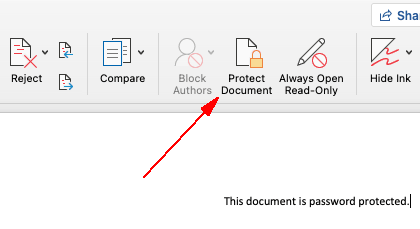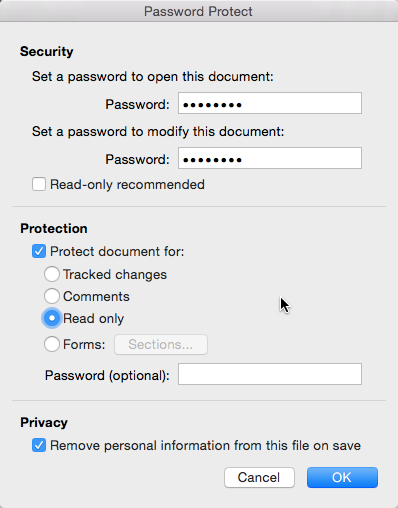
:max_bytes(150000):strip_icc()/006-how-to-unlock-a-word-document-4173003-7d094e155b51454380d224684f1daa46.jpg)
- MICROSOFT WORD FOR MAC CAN YOU PASSWORD PROTECT A DOCUMENT? HOW TO
- MICROSOFT WORD FOR MAC CAN YOU PASSWORD PROTECT A DOCUMENT? WINDOWS
Add innocuous text the visible version of the file and store your passwords or other sensitive data in the hidden file.
MICROSOFT WORD FOR MAC CAN YOU PASSWORD PROTECT A DOCUMENT? HOW TO
The How-To Geek explains how to use the Alternate Data Streams feature built into Windows' NTFS to create a secret text file associated with a visible one. Storing your passwords in this manner is not as safe as never recording them, nor is it as safe as using a separate utility that lets you apply a password to a file (come on, Microsoft!), but for lots of folks, it's safe enough.

You may also need to disable the spelling and grammar checker in the document to prevent squiggly lines from appearing under the passwords. Enter your passwords (along with the extra characters to defeat clipboard readers) invisibly at the end of existing lines that have enough room for them, or scroll to the bottom of the document and enter the passwords there. Here's one clever way to get around that problem.įirst, open an innocuously named file, such as "grocery list.txt" or "definitely not my passwords.rtf." Change the text color to match the background color (probably the default, white).

MICROSOFT WORD FOR MAC CAN YOU PASSWORD PROTECT A DOCUMENT? WINDOWS
Unfortunately, Windows doesn't let you password-protect a file or folder. You can encrypt a file in Windows by right-clicking it and choosing Send to > Compressed (zipped) Folder. Four ways to protect documents in Word for Mac 2011 are Tracked Changes, Comments, Forms, and Read-only.Īn imperfect workaround for Windows' missing-password option The options shown when you click the Protect Document button are Tracked Changes, Comments, Forms, and Read-only, in addition to the password-entry box. Word for Mac 2011 lets you require a password to open and/or modify the file, make the file read-only, and remove personal information on save. Other options let you make the document read-only, remove personal information from the file when you save it, and warn that comments and tracked changes are in the document (the option to warn before opening a file that contains macros is selected by default). Enter a password in the "Password to open" and/or "Password to modify" boxes. The options are different in Word for Mac 2011: open the document, click Word > Preferences > Security. Other options let you restrict editing to specific people or groups, limit formatting styles, and make the document read-only. You can require Track Changes or limit changes to comments. To limit the type of changes others can make to the document, choose the Restrict Editing option under Protect Document to open the Restrict Formatting and Editing window. Type the password and press Enter, then confirm the password and press Enter again. Apply a password to a document in Word 2010 by choosing the Encrypt with Password option under Protect Document. In Word 2010, open the file and click File > Info > Protect Document > Encrypt with Password. (Note that some sites don't let you paste text into the password field.) That's why John has to add extra characters to his passwords that he will delete after pasting. Of course, John's passwords are vulnerable to clipboard loggers that capture the contents of the clipboard just as key loggers grab your keystrokes. John just has to remember to type in one password: the one he uses to encrypt and password-protect his Word password document. asked whether it was safe to store his passwords in a Word DOC file and then copy and paste them into sign-in screens to thwart keystroke loggers. Following my post earlier this month on " Ten simple, common-sense security tips," reader John B.


 0 kommentar(er)
0 kommentar(er)
